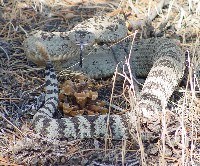
Tod Williams Western Rattlesnake Great Basin rattlesnakes (Crotalus viridis lutosus) are the only venomous reptiles in most of the Great Basin desert. They are best identified by their blunt, rattle-tipped tail & thick, stocky bodies. Adult Great Basin rattlesnakes average 30-36 inches in length, and are tan to yellow in color, with a series of darker oval blotches on their back. Great Basin rattlesnakes may occur up to 11,000 feet in elevation, but are more common below 8,000 feet, in a variety of habitats- greasewood/shadscale, sagebrush, pinyon/juniper, & fir/spruce. The unifying characteristic of rattlesnake habitat in the Great Basin is rock. Great Basin rattlesnakes hibernate in dens, southern exposed rock outcrops, during the winter, emerging in May to bask in the spring sun. Males and non-reproducing females disperse into surrounding areas to forage for mice, rats, ground squirrels, gophers, birds, & lizards. A mature male may move up to 2.5 miles away from the den. Gravid (pregnant) females remain near the den, basking frequently to facilitate proper development of their developing embryos. In mid to late September they give birth to 5-8 live baby rattlesnakes, remaining with them for the first 7-10 days of their life. Mortality is high among newborn rattlesnakes with less than 10% surviving to sexual maturity. By late September the rattlesnakes have gathered back at the den site. As temperatures drop the rattlers re-enter their den to spend another winter underground, another annual cycle completed. Great Basin rattlesnakes are fascinating and beautiful animals. Their venomous bite, although rarely fatal & used only for feeding and defense, commands respect & common sense in their presence. To avoid being bitten:
If you see a rattlesnake in your campsite contact a ranger. The chances of being bitten are EXTREMELY low. If however you are bitten by a rattlesnake: DO NOT:
DO:
Take some time to learn about rattlesnakes and other reptiles. Perhaps if you are lucky you will see or hear one during your travels. Rattlesnakes are protected in national parks but often are not on other public lands. With some knowledge & understanding of the biology of rattlesnakes, you will know how to react when you encounter one of these remarkable animals. Article written by: Bryan Hamilton, 2000 |
Last updated: May 11, 2023
